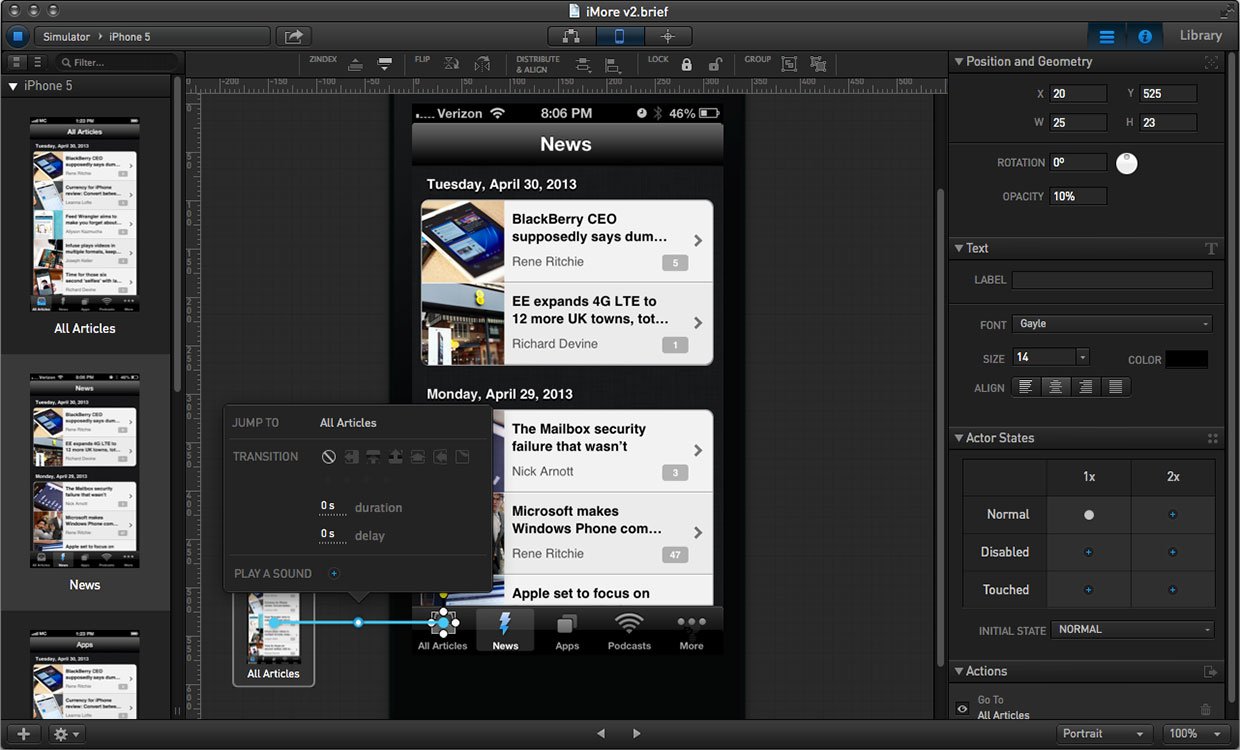"Providing a clean interface and intuitive layout, Briefs offers an easy way to prototype apps, share ideas, tweak functionality, and adjust designs as new feedback arrives and your project evolves. It’s an app made for professionals, by professionals."
Briefs 2 is a Mac app by MartianCraft that allows you to quickly and easily create, edit and share prototypes for iOS and Android apps. Prototyping allows you to hash out features and designs before full development on a project begins, when it’s still easy and relatively inexpensive to make changes. A handful of iOS prototyping tools exist, but many of them have either fallen out of date or are simply lacking in functionality. Briefs seeks to provide a truly complete and professional solution for designers and developers. How well does it do?
Setting the stage
Briefs opens with a Welcome brief that helps you quickly acclimate and learn its basic functionality. I highly recommend going through the mini-tutorial as it will help you understand some of the foundational concepts of Briefs while also demonstrating a lot of Briefs’ power.
There's a bit of a theatrical paradigm to Briefs, which offers some key terminology to help you understand different components in a brief. Inside of a brief you create Scenes. A scene represents a state of a view in your app. To be clear, this does not mean a scene is equivalent to a screen in your app. Rather, each scene represents a specific state of a screen in your app. Some screens may only need one scene while others might require several. Within each Scene, you arrange your Actors. Actors are all of the elements that you arrange in your scenes; backgrounds, status bar, tab bars, nav bars, images, buttons, etc. For each scene you arrange your actors in the area called the stage... starting to see how all of these names give you a pretty good idea of what they’re referring to? In your scene, your actor can also have various states. For example, an actor that is a button can have tapped, untapped, and disabled states. These are the basic components that you’ll work with in Briefs.
Briefs comes with some pre-loaded actors for you to use. The Library button in the upper-right offers iPad and iPhone components in stock a iOS style as well as slightly more interesting Blueprint style. The library offers enough bars, buttons, tabs, backgrounds and icons for you to start piecing together some pretty basic iOS apps. However, you’ll likely want to import your own custom images that are designed for your app specifically before you get too far into prototyping.

As you create scenes, of course you’ll want to tie them together to illustrate how the app will flow, which is where Actions come in. Any actor that you add to a scene can be given an action. These actions control interactions between different actors and scenes. For instance, you could have an actor that is a button which, when pressed, will go to a scene that has an alert dialog present. An “OK” button on the dialog could then have an action to go back to the scene that did not have an alert dialog. When viewing this brief in the simulator or a device, it will appear to function like an alert dialog in an iOS app; you tap OK and the alert is dismissed. Actions can also be performed on other actors in the same scene with some basic animations like moving an actor, changing opacity, or playing a sound. All of the animations also use native code, so it won’t look close to how an animation would look in an actual app, it will look identical. And you’re able to accomplish all of this without writing a single line of code.
To make things even easier on designers, Briefs makes it extremely easy to export all of the assets from the prototype. In the File menu is an item called “Export Assets” that does exactly what you’d hope for. Briefs will create a folder for each timeline in your brief. Within each timeline folder will be a folder named after each of your scenes. And within each folder for each scene will be all of the assets that were in that scene. This should also make the lives of developers easier as it will help to ensure they always have the assets necessary for each view they work on.
I have to admit, even after going through the Welcome brief, I felt as if I was stumbling my way around the app. Although after spending some time in Briefs, I started to feel more comfortable in the app, and I think a slight learning curve is to be expected with a tool like Briefs. There’s a lot of functionality in the application and Martiancraft has actually done a pretty remarkable job of distilling it down to such a relatively simple interface. The focus of the application stays on your scenes and the stage. The rest of the dark interface just sort of gets out of your way until you need it.
As you iterate over your prototypes, Briefs is supposed to allow you to create multiple versions of your brief that you can easily switch between. Unfortunately I couldn’t get this functionality to work during my review. I actually ran into a number of bugs including versions not working while going through the app. While this isn’t great news, I was pleasantly surprised by the responsiveness of the developer. My support request was met with a pretty quick follow-up addressing the issues I was having. A number of the problems have already been fixed in version 1.0.2 and I anticipate the others will be fixed in another update.
Briefscase
So it’s fun to put together a prototype and play around with it on your computer, but how will it actually look on a device? Briefscase is the counterpart to Briefs that allows you to run prototypes on mobile devices; iPhone, iPad and Android. One way to play your prototypes in Briefscase is from Briefs, over your network. While this feature is a really neat idea, the performance seemed pretty slow for me, making it painful to use.
Fortunately you can also load a brief directly onto your device via a URL. Uploading your brief to a service like Dropbox or CloudApp allows you to open a URL for that brief on your device, and send it straight to Briefscase. This will allow you to view and interact with your prototype directly on your device. This had much better performance than trying to play it over the network, and the prototype was actually pretty enjoyable to go through on the device. This also means you can share your brief with co-workers, bosses, clients, customers or anybody else who wants to get a feel for the app you’re planning to create. A nice touch in Briefscase is the notes area you can access from any scene. When you’re away from your computer using the prototype and you have a idea for something you want to change or feedback you want to provide, the notes area provides a convenient place to record your thoughts.
The price
A lot of consumers will find the cost not only off-putting but prohibitive. While Briefscase is free, Briefs itself will set you back $199. It’s worth noting that this software is not geared toward average consumers. If you’re a student learning app development or somebody looking to just play around with an app idea you had, Briefs may not be the app for you. You may want to look for simpler software with fewer features. If you’re a development shop or professional designer, Briefs could easily pay for itself in the time you’ll save from using it. And if you wish you could take it for a test drive first, then you're in luck. Briefs has a pretty robust demo version that never expires which you can find on the download page below.
The bottom line
While Briefs does have a bit of a learning curve, and the Mac app still has some kinks to be worked out, I can easily see it becoming an indispensable tool for designers and developers. The small problems the app has currently should be addressed in future updates, and in the meantime are far outweighed by the functionality it offers. The cost is too high for many consumers, but is justified for any professionals with a need for a comprehensive prototyping tool. Providing a clean interface and intuitive layout, Briefs offers an easy way to prototype apps, share ideas, tweak functionality, and adjust designs as new feedback arrives and your project evolves. It’s an app made for professionals, by professionals.
- $199 - Briefs for Mac - Download now
- Free - Briefs for Mac demo - Download now
- Free - Briefcase for iOS - Download now


